by Sam Tackeff | May 17, 2010 | Books, omnivore books
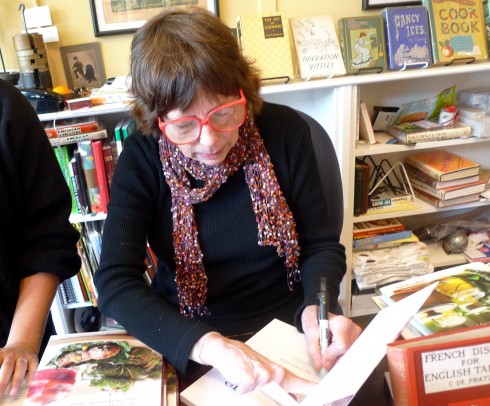
I’ve been thinking lately of how many amazing influential women I’ve met at Omnivore books over the past year. The list is pretty astounding – Paula Wolfert, Cindy Paulson, Alice Waters, Mollie Katzen (although she didn’t speak) to name a few. So I think I’m going to make a point to post about these great women – they deserve immense credit for changing the world of food for the better. Here is the latest in influential women at Omnivore:
Behind those super hip red glasses is a woman we should all respect – Victoria Wise.
At 27 years old, Victoria was the first chef at Chez Panisse in Berkeley. A former philosophy grad student at Berkeley, her cooking education was mostly trial by fire. The first dinner she cooked was Duck with Olives. She sourced the duck from Chinatown, made the stock, sauce, everything from scratch. One of the big lessons she learned that night – you can’t take a recipe for 12 and multiply it by 20 and expect it to turn out. It was, in her words, “Very Tomato-y”.
After Chez Panisse, she set up shop across the street and opened a charcuterie deli called Pig-by-the-Tail. “It was an artist’s workshop, it was not a business” she confided – but it was a different time then – like Chez Panisse, the goal was never to get rich, it was to make delicious food to share with friends. While Pig-By-The-Tail may not have made Wise wealthy, it gave her the material for her first book in a long line of cookbooks – “American Charcuterie“, a standard that we sell at Omnivore (nominated for a James Beard in ’87). (It’s out of print, but if you call we can send you a signed copy!)
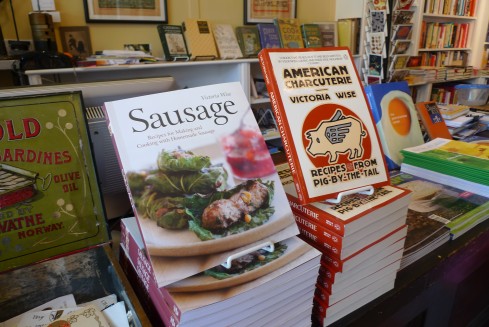
Since writing ‘American Charcuterie’, she has gone on to write over a dozen more cookbooks, including ‘Good & Plenty: America’s New Home Cooking’, ‘The Well-Filled Tortilla Cookbook’ , ‘Foods Of The World: Mexico’, ‘The Vegetarian Table: Mexico’, ‘The Well-Filled Microwave Cookbook’, ‘The Vegetarian Table: Japan’, ‘The Pressure Cooker Gourmet’, ‘Stories and Recipes from the Robert Mondavi Kitchen’, ‘The Armenian Table’, ‘The Olive and The Caper: Recipes’, and ‘Gastronomy, and Lore of Greek Cooking and The Gardeners’ Community Cookbook’. Her newest book, ‘Sausage’ came out just last month, and she has another book, ‘Bold Food’ on the docket.
As you can see, the breadth of her work is pretty incredible.
Victoria’s goal in life is to “convince people that they really can cook.” Her cookbooks are approachable, filled with great recipes, but importantly great stories. Cookbooks are so much more than recipes – a good cookbook creates the context for good eating. Victoria loves writing about food as much as she loves eating, and confided unabashedly that she thinks about food all the time.
That’s a woman I admire.
by Sam Tackeff | May 15, 2010 | Books, Cheese, omnivore books
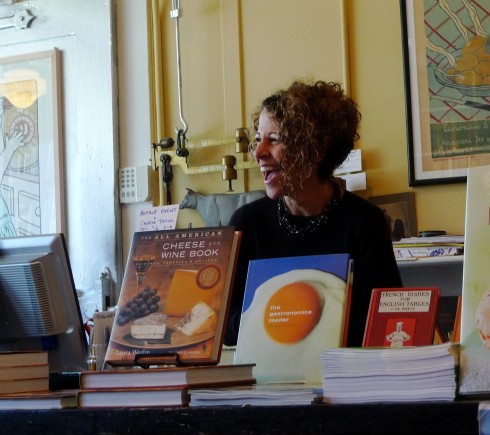
[This photo of Laura Werlin (cheese lover and author) is a perfect example of how much fun we have at Omnivore Books.]
Laura came by to talk about cheese, but more importantly, to lead us in a mini-tasting. We had a tasting of three American cheeses, all of which I’d purchase again, and recommend highly. Forgive my cheese-tasting notes, I need to work on cheese vocabulary without sounding inept or worse, ridiculous – “grapefruit and foie gras notes in that cheese Marty, don’t you think?…”
1. Crocodile Tears (See photo below) – made by Judy Schad of Capriole Dairy in Indiana. This was an aged but still soft goat cheese with a really smooth goat-cheesy texture, and nice tangy flavor. While sampling this cheese we learned that most goat cheeses are that characteristic whitish color because don’t metabolize beta carotene the same way that cows do, producing a lighter milk.
2. Pleasant Ridge Reserve – made by Uplands Cheese Company in Dodgeville, Wisconsin. A special cross breed of cows, and rotational grazing techniques used by the farmers makes this cheese a nice golden color. It was a firm (semi-hard?) cheese with such pleasant complex notes – a little bit like tasting the grass the cows were eating in the plains, just a little bit of nuttiness and a tiny crunch.
3. Oma – made in Vermont by the Von Trapp Farmstead, aged in the Cellars of Jasper Hill, one of the only Affineurs (cheese agers) in our country. Yes, those Von Trapps. We tasted this cheese last, as it was the most “aromatic” aka delightfully smelly. It was also wonderfully creamy.
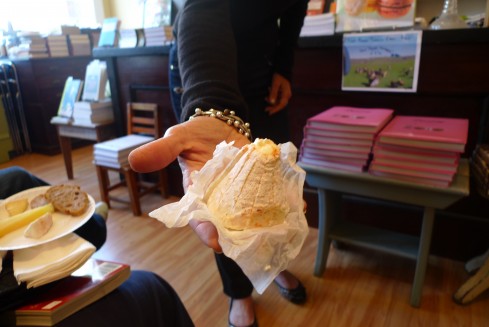
But maybe it’s something about people who work with cheese:
Here’s Gordon Edgar – Cheesemonger at Rainbow Grocery, and author of one of the best food books I’ve read this year. His book, ‘Cheesemonger: A life on the Wedge‘ single-handedly doomed me to uncontrollable cheese cravings for the past month. (Fortunately, my family just gave me a gift certificate to Rainbow Grocery for my birthday, so I now have the funds to spend it all on cheese. I’ll have to use restraint.)
I loved this book because the voice is uniquely Gordon Edgars’ – and is as passionate about cheese as he is about politics, activism, music, and the Bay Area. I learned more about my city from reading this book than from living here. (Which just tells me that I have to be more involved. Folsom St. Fair anyone?) In fact, I enjoyed it so much, that when I finished reading it…. I went back to his livejournal, which to my delight has archives dating back to 2002. I know, I’m a little creepy.
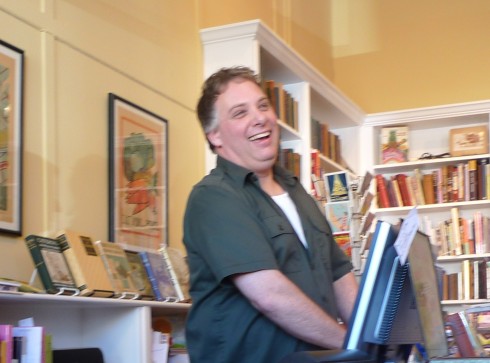
And he loves dogs! And dogs love him.. Maybe dogs also love cheese?
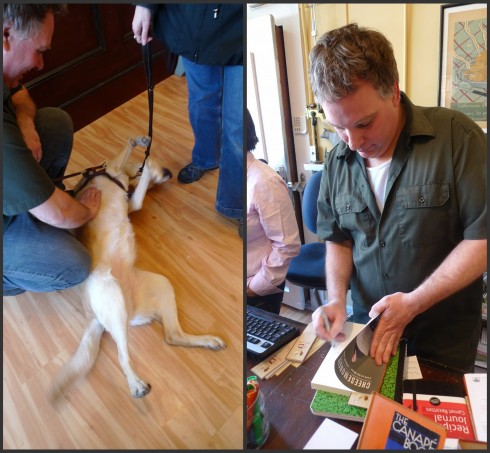
But then, he too fed us delicious cheese:
Dee Harley’s freshly made goat cheese from her farm in Pescadero. Not only was this goat cheese delicious and fresh, but I had the privilege to take home some of the leftovers. It went on asparagus, morning toast, and in a glorious trick – in the cavity of my roasting chicken. Delicious!!
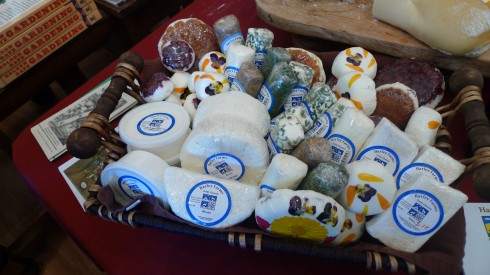
Jealous?
Come to Omnivore! Here’s the event calendar. There are events every week – usually on the weekends, but some excellent ones scheduled during the week as well.
As for more cheese lust- this is what I’ve been reading over the past few weeks:
It’s Not You, It’s Brie : Kirstin loves cheese, and works as a ‘cheese program director’ among other fabulous food related jobs. She also takes some beautiful photographs of cheese, and makes me hungry on a regular basis.
@formaggio on twitter: I follow Formaggio Kitchen because I’m a masochist. Some of the best cheese (and foodstuffs) on the East Coast. A few years back I went to a cheese tasting with Ihsan Gurdal (the owner) at Tanglewood. Do it if you have a chance.
Gordon Edgar’s Blog: Yes, the Cheesemonger keeps us updated and laughing.
I also am in the middle of reading ‘The Town That Food Saved: How One Community Found Vitality in Local Food‘ about a community in Vermont at the center of a food revolution/scandal/hype/or what have you. (You’ll have to read it.). It also has a good amount of information on cheese and dairy’ing. Worth a look.
by Sam Tackeff | Mar 7, 2010 | Books, Restaurants
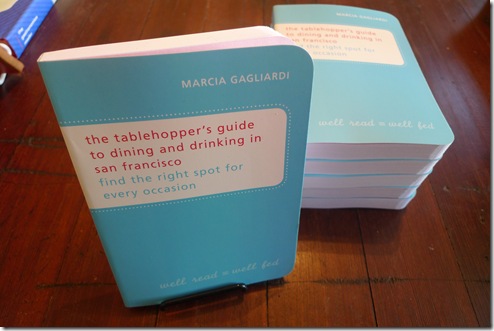
Before I even moved to San Francisco, I started plotting where I would eat. I picked up (and annotated) a Zagat guide, I read through a copy of ‘The Cheap Bastard’s Guide to San Francisco’, I started reading Yelp reviews, all in addition to the 30 or so San Francisco bloggers I was relying on to steer me in the right direction. I was armed with a long list before I ever stepped foot on California soil.
And then, as soon as I got here, I discovered a great new addition to my growing arsenal: ‘The Tablehopper’ newsletter, written by the ever charming Marcia Gagliardi. First of all, I should start by saying that this woman knows how to eat.
Her weekly newsletters are a combination of local reviews, restaurant news, food news, food gossip and events, and numerous ideas to fill your calendar and to-do list. I read it partially because it gives great advice, partially because it makes me giggle, and partially because I’m a masochist and it’s impossible not to be completely jealous of her gastronomic adventures.
And now she’s in print!
Enter Marcia Gagliardi’s new book: ‘The Tablehopper’s Guide to Dining and Drinking in San Francisco – Find the Right Spot for Every Occasion’. Thanks to Ten Speed Press, I got my hands on an early copy of this book, and it became immediately clear how useful it is.
For anyone (like myself) who decides on restaurants specifically based on emotions or occasions, this book is organized by particularly useful sections including:
- Dinner with Your Parents (Conservative or Cool Ones)
- Offbeat or Ethic Group Dinner Locations
- Hip, but not a Total Scene (Slightly Spendy)
- Co-worker Birthday Lunch
- Good (or Hip) Spots for Solo Dining
- Hungover (Can’t Leave Bed)
- There are also 1, 2, and 3-day Itineraries for those visiting the city, and sections organized by food type, such as Pho or Dim Sum
Now, when I’m looking for inexpensive vegetarian, gluten-free, a place to take my grandmother, or the perfect burger, I have all the information right at my fingertips, and it fits easily in my bag. This is a great gift for anyone living in San Francisco, or anyone planning a gastronomic trip to San Francisco.
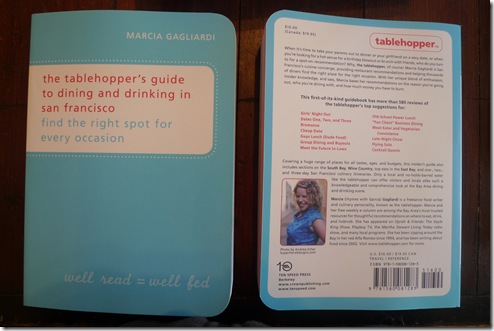
Follow Marcia on Twitter (while you are at it, follow me on twitter) or subscribe to the Tablehopper newsletter to get tasty ideas for bay area dining every week in your inbox.
Or come visit Marcia, (and me!) in a few weeks here at Omnivore books:
Wednesday March 24th, 6pm, free Book Signing at Omnivore Books 3885 Cesar Chavez St. at Church, San Francisco. Andrew Mariani of Scribe will be pouring his delicious 2008 Pinot Noir, Carneros, Sonoma. Yes, there will be free wine. Who doesn’t love free wine?
* * *
The Tablehopper’s Guide to Dining and Drinking in San Francisco: Find the Right Spot for Every Occasion by Marcia Gagliardi; Chronicle Books, 230 pages.
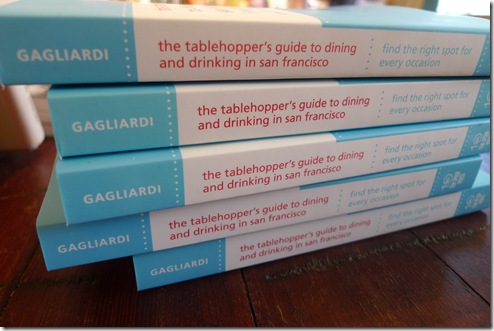
by Sam Tackeff | Mar 3, 2010 | Books, Indian, Pantry Staples

For the past few weeks I’ve been cooking up an South Asian storm. I love the flavors and spices in all types of South Asian food – and use many traditional ingredients in my everyday cooking – a lot of ginger, turmeric, cumin, and coconut milk to name a few.
I just wrote my first review up at The Good Taste Review for Ruta Kahate’s book ‘5 Spices, 50 Dishes’. Head on over and let me know what you think!
I didn’t want to leave you all hanging, so this chickpea recipe is one of my favorites that I tried from the book. I love chickpeas in any permutation, but this recipe was particularly fresh and light. It could either make a nice side dish, or a good vegetarian meal if served over rice. When I first made it, I ate it as my dinner, and was quite satisfied. Although the recipe called for canned chickpeas, I made this with Rancho Gordo chickpeas that I had soaked overnight and cooked.
Chickpea Curry with Fresh Dill Leaves
from ‘5 Spices, 50 Dishes’, page 42
Serves 4
This recipe traditionally uses a split and skinned Indian chickpea called chana dal, but I’ve found that canned chickpeas work just as well – which makes it possible to create this dish in minutes. The other interesting thing is that it uses dill leaves in the typical Indian style – as a vegetable, rather than as an herb. Serve with Marathi Yellow Fried Rice (page 103), and Roasted Onion Raita (page 98) for a hearty vegetarian meal.
-
2 tablespoons canola oil
-
1 medium yellow onion, finely chopped (about 1 1/2 cups)
-
1 teaspoon cayenne (or less)
-
1 teaspoon coriander seeds, finely ground
-
1 teaspoon finely grated garlic (about 2 large cloves)
-
1 teaspoon finely grated fresh ginger (about 2-inch piece)
-
1/2 teaspoon ground turmeric
-
1 medium tomato, finely chopped (about 1 cup)
-
3 cups finely chopped dill leaves and tender stalks (about 2 bunches)
-
One 15.5 ounce can low-sodium chickpeas (garbanzo beans), drained
-
1/4 cup water
-
1 teaspoon salt
Heat the oil in a medium saucepan and sauté the onion over medium heat until it has softened, about 5 minutes. Add the cayenne, coriander, garlic, ginger, and turmeric and stir for 3 to 4 minutes. Mix in the tomato and cook until it is soft, about 5 minutes. Add the dill, chickpeas, water, and salt, and simmer until the dill is soft and tender, 5 to 8 minutes. Serve warm.
by Sam Tackeff | Dec 4, 2009 | Books, Pantry Staples
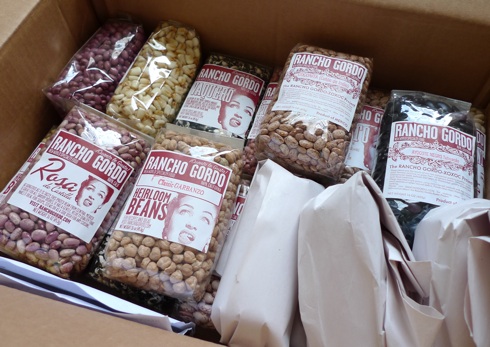
They came!!! A box full of Rancho Gordo beans in many colors and shapes and sizes! Think of the possibilities! I’m getting so hungry! I ordered these as a reward for some hard work in the “personal wellness department” – nothing like rewarding yourself with something healthy, tasty and delicious. They also make great unique gifts.
When I posted my bean soup a few days ago, I actually got private emails from people confiding that they had no idea what to do with beans, and asking what I did with them other than the spicy bean soup and chili. For me, beans are pretty much a daily food, and I’m almost never eating the same bean dish twice!
At the beginning of the week, I like to cook a batch of dried beans. Canned beans are fine (I tend to have a few cans of organic beans in the pantry for emergencies) but dried beans are so much better – particularly organic and heirloom varieties – they just taste better and have more texture. They also have much lower levels of sodium, which is added to the cans as preservatives – so if you do use canned beans, make sure to give them a rinse before cooking. I like to buy my dried beans from Rainbow in San Francisco, Phipps Country Store, or from bulk bins in a store that has large turnover to ensure freshness. Heirloom beans from Rancho Gordo are great because they are less than a year old, and the fresher the bean – the more nutrients, the better the taste and the quicker the cooking time. All it takes is a soak over night and a few hours in some boiling water – it’s mostly hands off. They are also perfect for slow cookers, so theoretically you wouldn’t even have to be at home while they cook.
For those of you concerned about the, erm.. “Musical Quality” of beans – there are a few things that you can do – try boiling your beans with a strip of Kombu (kelp – from which the taste Umami was discovered), or the Mexican herb Epazote, both of which help break down certain chemical compounds in the beans and reduce the post-bean-consumption concerts.
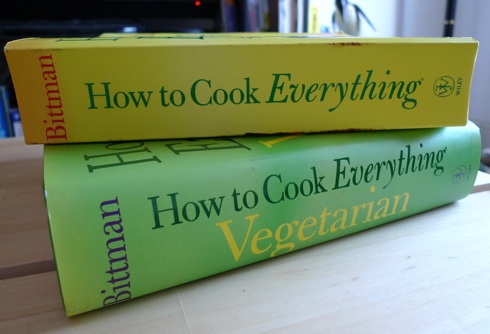
I like to alternate different beans each week for variety. My current favorites are Borlotti beans (cranberry beans), garbanzos (chick peas), and Christmas Limas, but I’m always out on the hunt for new varietals that I haven’t tasted. After cooking my batch at the beginning of the week, I add the cooked beans to soups, salads, mash them on sandwiches, throw into omelets, mix with salsa and top with some cheese, or dress them with a vinaigrette. I also like tossing them with roasted vegetables, making chili, and eating them with dark leafy greens such as collards, kale, or chard. I get a lot of great ideas from Mark Bittman’s Books – How to Cook Everything and How to Cook Everything Vegetarian. And from the cookbook “Heirloom Beans” by Steve Sando of Rancho Gordo, and Vanessa Barrington.
Another trick I use to make beans (or anything else for that matter) interesting is my “pick an ethnic cuisine, and use the right flavors from the condiment collection to flavor the food in that way.” Every culture has recipes for beans, and it’s fun to experience a global bean perspective. This is where having a good pantry comes in handy. For instance, I might decide that I want my beans to taste Moroccan – so I might pick lima beans, and flavor them with cumin, cinnamon, and pepper, and serve it over cous cous. Or I might want to go Indian, and choose kidney beans and lentils with curry powder and garam masala. Mexican? Maybe saute some onion and red pepper, and add black beans with oregano and mexican red chile. It’s not a perfect science, or perfectly authentic, but it’s a great way to mix things up and keep the taste buds excited.
When in doubt, I crack out some of my great regional cookbooks, or look on the blogs for new ideas. I recently made Red Beans and Rice, adapted from John Besh’s really fantastic My New Orleans Cookbook (ok, I didn’t have ham hocks but I used andouille sausage). Elise from simply recipes also has a great recipe for red beans and rice. I also love making Turkish dishes like Kuru Fasulye, simmered white beans and meat, (a good recipe from Zerrin’s blog), or Barbunya Pilaki – a cold bean salad in olive oil, like this one from Almost Turkish recipes. Or, you can go for the baked beans route – not totally traditional, but I happen to really like Heidi Swanson’s Beer Baked Beans.
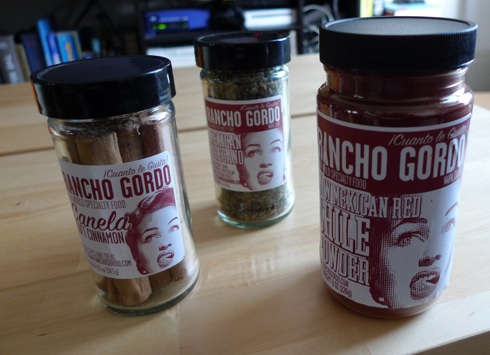
Some more bean ideas:
1. Make your own hummus – mash cooked garbanzo beans (chickpeas) with a spoonful of tahini, lemon juice, olive oil, and salt. You could also do it with cooked white beans, and bonus points if you top it with some pine nuts, a dusting of cumin, and fresh mint or parsley.
2. Refried beans – works great with cooked pinto beans or black beans – heat some oil/lard/or butter in a skillet, saute some onion (optional), and add mash your beans into it with a little bit of water. Cook until everything is warm, and season with a little salt, and maybe some cheddar or tapatio sauce if you have it. Top maybe with salsa and guacamole if you want, and eat with a warm tortilla.
3. Beans and a fried Egg – top plain beans, refried beans, bean soup, bean mash, you name it – with a fried egg. Poke egg, and stir into beans, and it’s just plain delicious. Although, frankly you top a good, organic, pastured egg on pretty much anything and it’s delicious.
4. Beans and Pasta – you could add cooked cannelini (white beans) or borlotti (cranberry) beans to your spaghetti and red sauce, or toss them with garlic and olive oil with some short pastas like campanelle or penne and top with a good dusting of black pepper and Parmesan.
5. Beans as a side dish – one of my favorite preparations of really any bean is simply tossed in a simple vinaigrette. This works best when the beans are still warm from cooking, but after tossing you can whack it in the fridge until about 20 minutes before you are ready to eat, at which point you take them out and let them get to room temperature. You can add freshly chopped vegetables such as tomatoes, cucumber, red bell peppers, and trim in fresh herbs like parsley and mint, and add in some salty cheese such as feta, or even hard cheeses like an aged parmesan.
And this is just the tip of the iceberg.
Seriously folks, the possibilities are limitless. Just get a pound of beans and go for it.
by Sam Tackeff | Nov 18, 2009 | Asian, Books, Japanese, Pantry Staples, Quick and Easy, Soups
 This week one of those hokey “name 3 things you like to eat, 3 places you’ve lived, and forward it to everyone!!!” emails circulated throughout my friends, with one noted similarity between all of our responses: It seems that we all have a voracious passion for bacon. Clearly our love for bacon will unite us for all time in friendship, so that’s exciting. And really who can blame us? There is so much you can do with the product – one slice lends entire flavor to soups, served crisply with eggs it is a miracle, even covered in chocolate there is demand.
This week one of those hokey “name 3 things you like to eat, 3 places you’ve lived, and forward it to everyone!!!” emails circulated throughout my friends, with one noted similarity between all of our responses: It seems that we all have a voracious passion for bacon. Clearly our love for bacon will unite us for all time in friendship, so that’s exciting. And really who can blame us? There is so much you can do with the product – one slice lends entire flavor to soups, served crisply with eggs it is a miracle, even covered in chocolate there is demand.
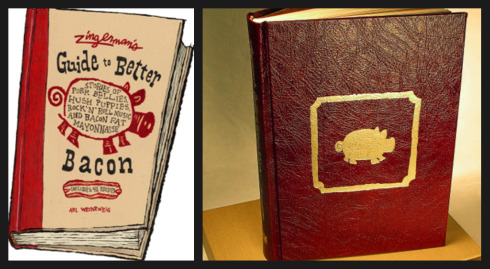 At the bookstore we have been selling copies of “Zingerman’s Guide to Better Bacon”, a rousing tour of bacon’s history (which for $300 you can get yourself a pigskin bound copy), as well as the Bacon Cookbook, which should have a prominent place in every bacon lover’s kitchen. In an unscientific poll that I’ve conducted, those most likely to buy these books were in a sub-set group of customers of which I include myself: the “JPAB’s”, say it: “Jay-Pab’s” or “Jews passionate about Bacon”. Maybe being deprived of bacon as a child led to my obsession, but really I think it’s actually a mix of deprivation and a greater cultural legacy- we Jews have a penchant for perfect savory brunch food – lox, whitefish, chopped liver, cream cheese, bagels – it’s no wonder that bacon sneaks itself in somehow.
At the bookstore we have been selling copies of “Zingerman’s Guide to Better Bacon”, a rousing tour of bacon’s history (which for $300 you can get yourself a pigskin bound copy), as well as the Bacon Cookbook, which should have a prominent place in every bacon lover’s kitchen. In an unscientific poll that I’ve conducted, those most likely to buy these books were in a sub-set group of customers of which I include myself: the “JPAB’s”, say it: “Jay-Pab’s” or “Jews passionate about Bacon”. Maybe being deprived of bacon as a child led to my obsession, but really I think it’s actually a mix of deprivation and a greater cultural legacy- we Jews have a penchant for perfect savory brunch food – lox, whitefish, chopped liver, cream cheese, bagels – it’s no wonder that bacon sneaks itself in somehow.
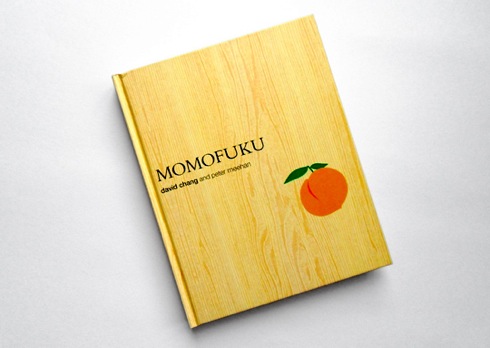 (Photo Helen Rosner/Eat Me Daily)
(Photo Helen Rosner/Eat Me Daily)
I’m always looking for new ways to use bacon, and most recently stumbled across a miracle in my new Momofuku cookbook – Bacon Dashi. Dashi, a traditional japanese stock made of konbu (kelp), and bonito flakes (dried fish, which has been powdered), is a staple broth that can be used in a myriad of ways. In the Momofuku cookbook, (of which a brilliant review can be found at Eat Me Daily), David Chang substitutes more easily findable smoky bacon for bonito, to create of this ever useful base broth. I made a batch last week, and have been using it in everything.
Things to use Momofuku Bacon Dashi for:
:: As the liquid for any soup, stew, grain, rice, or polenta. ::
Or:
1. Bacon Dashi over “stuff”: Slice shiitake mushrooms and green onions (scallions) in a bowl, and some silken tofu if you have it. Ladle hot Bacon Dashi over the contents of the bowl. Sit. Drink with glee. You know, I haven’t tried this, but I bet if you were to crunch up some of those onion strings that people put in green bean casserole in the bowl as well – it would taste good too.
2. Bacon Dashi Miso Soup – use the Bacon Dashi in this perfect and easy recipe for miso soup from Maki of Just Hungry.
3. Quick Bacon and Cabbage soup: Chop one strip of thick cut bacon and cook over medium high heat in a large soup pot. Add in one chopped onion and three minced cloves of garlic, and cook for about 4 or 5 minutes until slightly tender. Add in one chopped carrot, and rip in three leaves of sage. (If you have a potato, cube it into really small pieces, and add it here). Add a tin of cannelini beans, or great northern beans. Cook for about two minutes, and add 6 cups of Bacon Dashi – or a mix of water and dashi if you don’t have enough bacon dashi because you have used most of your double batch in the past few days. Bring to a boil, then turn down the heat, cover, and simmer for 20 minutes. Add in a half head of cabbage, roughly chopped, and 1 tablespoon of white miso paste and simmer for 10-15 more minutes. Season with some pepper, and serve.
*If you don’t have white miso paste, you could just salt at the end, but it wont have that nice unctuousness and depth that the miso adds to the soup. Buy yourself a little tub, and use it!
Momofuku Bacon Dashi
from the Momofuku Cookbook
Makes 2 Quarts
Two 3-by-6-inch pieces konbu (kelp)
8 cups water
1/2 pound smoky bacon, preferably Benton’s
1. Rinse the konbu under running water, then combine it with the water in a medium saucepan. Bring the water to a simmer over medium heat and turn off the stove. Let steep for 10 minutes.
2. Remove the konbu from the pot and add the bacon. Bring to a boil, then turn the heat down so the water simmers gently. Simmer for 30 minutes.
3. Strain the bacon from the dashi, and chill the broth until the fat separates and hardens into a solid cap on top of it. Remove and discard the fat and use the dashi or store it. Bacon dashi will keep, covered, for a few days in the refrigerator.
*Notes: All Asian grocery stores and most health food stores will carry dried konbu (kelp), although increasingly it is found in the Japanese part of the “world” section of the American supermarket. As to the bacon, I used Niman ranch thick cut apple-wood smoked bacon, and it worked out just fine.
*Also, you can half this recipe, or if you are smart, double it.
*Also, you can eat the konbu for snack instead of throwing it out. I wouldn’t advocate the same with the boiled bacon.
Other people using Bacon Dashi in creative ways:
Anticiplate: Southern Style Shrimp ‘n Grits
Inuyaki: Bacon Agedashi Tofu















 This week one of those hokey “name 3 things you like to eat, 3 places you’ve lived, and forward it to everyone!!!” emails circulated throughout my friends, with one noted similarity between all of our responses: It seems that we all have a voracious passion for bacon. Clearly our love for bacon will unite us for all time in friendship, so that’s exciting. And really who can blame us? There is so much you can do with the product – one slice lends entire flavor to soups, served crisply with eggs it is a miracle, even covered in chocolate there is demand.
This week one of those hokey “name 3 things you like to eat, 3 places you’ve lived, and forward it to everyone!!!” emails circulated throughout my friends, with one noted similarity between all of our responses: It seems that we all have a voracious passion for bacon. Clearly our love for bacon will unite us for all time in friendship, so that’s exciting. And really who can blame us? There is so much you can do with the product – one slice lends entire flavor to soups, served crisply with eggs it is a miracle, even covered in chocolate there is demand. At the bookstore we have been selling copies of “Zingerman’s Guide to Better Bacon”, a rousing tour of bacon’s history (which for $300 you can get yourself a
At the bookstore we have been selling copies of “Zingerman’s Guide to Better Bacon”, a rousing tour of bacon’s history (which for $300 you can get yourself a 
